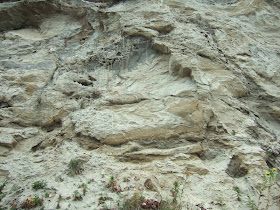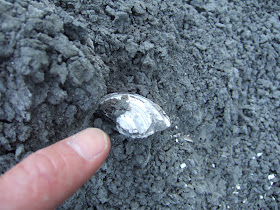I was doing some research on snow pack and glacial ice in the Cascade Range and looked at few of the glaciers that were in my graduate field area. My graduate field work was focused on rocks not glaciers, but glacial ice and snow turned out to play a critical role to my work. And after looking at some glacier and snow pack images of my field area, I realize that I may have been very lucky.
My graduate field area in the North Cascades - The Eldorado Contact indicated by #2
This is the second post regarding my past graduate work (#1 on the map above is
HERE).
The initial goal of my graduate work was to determine the direction and timing of the faulting that placed the low pressure Eldorado Pluton adjacent to very high pressure metamorphic rocks in the Crystalline Core of the North Cascades Range. The contact between the Eldorado Pluton and the adjoining high grade schist was well mapped, but the faulted nature had been surmised by the sheared rocks observed near the contact and the disparity between the high pressure mineral assemblage in the schist and the moderate pressure mineral assemblage in the pluton. The actual mapped fault had not been previously observed even though it showed up on the Washington State Geology map at the time.
So the big challenge was actually finding the contact. My initial efforts focused in the Cascade Pass area and a few other areas that looked promising, but I was frustrated by the vegetation, soils, glaciers and very inconvenient younger intrusive rocks (I cursed andestic dikes and pegmatites) covering or obscuring the needed exposures of what I wanted to see. I found wonderful exposures of high grade metamorphic rocks and wonderful exposures of Eldorado Pluton, I measured foliations and shear markers, collected oriented samples for later microscopic viewing, but the actual fault contact remained hidden.
Site #2 on the map above is where I finally reached a contact location. This site took some effort to reach. We hiked into a high camp from the Cascade River Road up the brutal slog to Monogram Lake and then a couple more tired miles up to a bedrock ledge next to a glacier that was out of the bear invested meadows. The hike to this camp involved nearly 5,000 feet of elevation gain followed by a drop of 1,000 feet and then another climb of 1,000 or more. The first night at this camp the mountains became socked in with fog and it was too dangerous to attempt route finding towards the contact I so much wanted to see. We did other work before the weather turned really bad and we retreated out of the sleet and rain. Hence, the hike had to be repeated.
This second effort brought success. And in retrospect a bit of great luck provided by the small glacier on the north side of the ridge.
Google Earth image from Summer 2011.
Previous geologists had passed along this ridge. I suspect that their routes took them along the high meadows on the south side of the ridge. And if that is the route they followed, they would not have been able to see the contact between the Eldorado and the schist. I hiked all over that slope and could not find a contact. They would have been close but would nit have seen it.
But on the north side of the ridge I got very lucky. Previous mappers had worked this area in the 1960s. Look at the above image and one can see a nice fresh slab of exposed bedrock north and down slope from the small glacier. The glacier has receded exposing a slab of fresh bedrock. I am not certain that the area of exposed bedrock in the 2011 image was glacier covered on the 1960s, but I highly suspect it was and at the time I was pretty convinced I was looking at fresh outcrops no one else had ever seen. But looking at the 2011 image above, I realize that I was even luckier than I thought. I had zoomed into the image to see if I could see the Eldorado/Schist contact, but in the above image the contact is ice covered.
2011 was a big snow year in the North Cascades and the snow lingered late. In addition, the small glacier appears have advanced or expanded. Indeed other Google Earth images hint at an expansion of the small glacier. The point is, if one were to traverse the slope below the snow and ice at the time the 2011 image one would not be able to observe the contact between the Eldorado and the adjoining schist like I had.
The Google Earth image from 1998 though shows much less snow and ice and the contact between the units can readily be discerned.
Google Earth 1998
Dark amphibolite schist is on the left of contact line and light Eldorado tonalite is to the right
In all my tromping around the Eldorado Pluton, this was the only place where the contact was not obscured. This one site more than made up for the lack of good observations elsewhere with over 300 feet of continuous contact between formations extremely well exposed in freshly glaciated bedrock slabs with virtually no weathered surfaces.
And from a research perspective, I was lucky again. The fault turned out not to be a fault. This one site definitively demonstrated that the Eldorado Pluton had intruded into the surrounding bedrock. This finding completely altered my thesis project and provided a nice data point in timing of major North Cascades tectonics - the high grade metamorphism took place after the pluton had intruded into the schist (
Intra-arc loading). A small contribution to the bigger picture. And I take some self-satisfaction that a fault that was previously on the State Geology map has since been removed.
I should add that after spending a lot of time trying to find the Eldorado contact, I had become suspicious that it was not a fault. This was particularly true after going from outcrop to outcrop in the meadow area on the south side of the ridge shown above. The tricky climb down to the north side of the ridge had to wait the next day, but before we made the descent, I was fairly convinced I was going to see an intrusive contact.





























